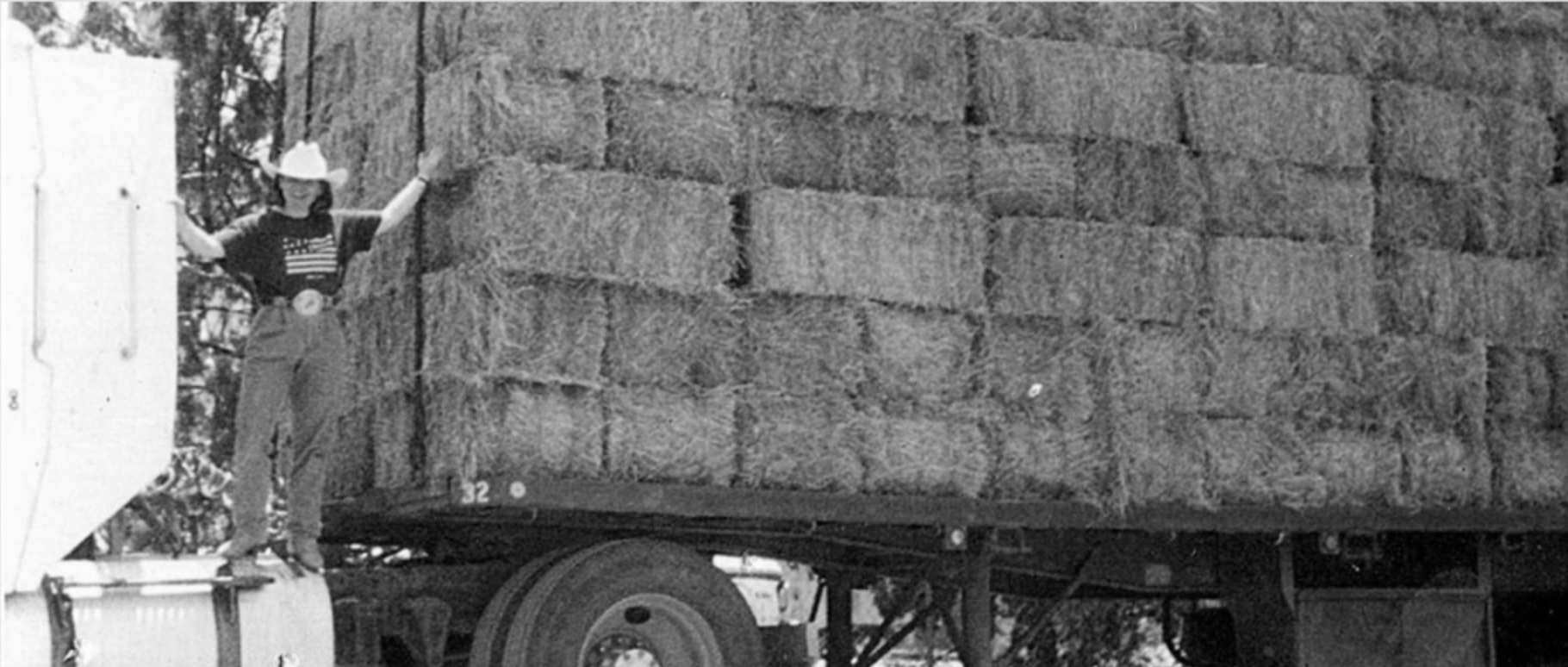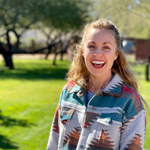What Horses in Nature Know (That We Often Forget): A Conversation with Liz Blitzer of Hay USA
August 7, 2025

I recently had the pleasure of talking with Liz Blitzer, founder of Hay USA, and let me tell you, this woman knows hay. With 36 years of experience running what has become the largest custom hay company in America, Liz has helped thousands of horse owners rethink their feeding practices. While her expertise is impressive, what struck me most during our conversation was her raw honesty, passion, and deep devotion to horses.
We hopped on an actual phone call (remember those?), just two days after she had been dealing with a digestive tract health scare involving her beloved gelding, McLain, a 20-year-old Quarter Horse she rescued at six weeks of age.
This experience reminded her about the all-too-common gap between veterinary care and nutrition. “Vets are not taught extensively about nutrition in vet school,” she said plainly, “just like human doctors are not taught about nutrition in medical school.”
Despite the sometimes uphill battle of educating people about the importance of helping horses heal through proper forage feeding, Liz is energized by all of the opportunity. Here are some of her top suggestions and tips for helping horses thrive, no matter their location, discipline, or living situation.
Meet Liz Blitzer: The Woman Behind Hay USA
First, I have to give you a little background on this incredible woman. Liz Blitzer grew up in Southern California, where she started riding horses as a young girl. Her father would take her to Pickwick Stables in Burbank every Sunday where she rode a horse named Fleet for $3 an hour. After college, she worked under a Hollywood set designer, until she found her way back to horses and opened her first retail store, called Cowboys and Indians, which specialized in western collectibles. This store became the hangout location for icons such as Dick Farnsworth, Walt LaRue, Glen Randall (who trained Roy Rogers’ famous horse Trigger), and many others. Randall came in one day, asked if she wanted to try selling hay, and so began the journey of Hay USA in 1989.

Knowing nothing about hay, she set out to learn everything she could. Like any great story, she faced many challenges, and through her travels, discovered that Texas had quite the demand for premium hay. Through some inspired interactions with strangers and friends, she ended up in Weatherford, and the rest, as they say, is history.
Liz is truly a force of nature, always willing to learn and to put her entire heart into what she’s doing. She is known for her grit, candor, and a kind of no-nonsense wisdom that only comes from decades of hands-on experience. Liz has, quite literally, built her business from the ground up walking hay fields, sourcing the cleanest forage, and refusing to compromise on quality or integrity.
It is clear from talking to her that the wellbeing of the horse and the owner is what keeps her up at night and keeps her moving forward every day.
The Three Rules of Feeding Horses
When I asked Liz what she wished every horse owner knew, she didn’t hesitate:
-
Free-Choice Hay is Non-Negotiable. Horses are grazers by design. If your horse doesn’t have access to hay 24/7, you are working against nature. Period.
-
Use Probiotics Daily. In her words: “Probiotics are essential for any living being with a stomach. And don’t forget that probiotics are living organisms, which means they also need food. Prebiotics are just as important. FullBucket supplements are the gold standard for lots of reasons, but one of those reasons is that they contain both pre- and probiotics.”
-
Keep Sugars Low. This is especially critical if you are dealing with a horse prone to founder, laminitis, metabolic syndrome, or insulin resistance.
The Fact of the Fiber Mat Matter
Liz isn’t afraid to challenge conventional beliefs. She recommends that owners ditch coastal and cubed hay and instead free-feed a mix of timothy and alfalfa. The calcium in alfalfa supports overall gut and hoof health, while timothy hay builds a fiber mat.
Here’s why the fiber mat is so important: The horse’s stomach has two regions: The glandular portion is protected from stomach acid, while the non-glandular region is vulnerable to stomach acid.
Because horses were designed to eat constantly, this slowly layers plant fiber into a “floating mat” in the stomach. This mat acts like a barrier, shielding the unprotected area from stomach acid. Without the fiber mat, stomach acid splashes around, and can create circumstances for ulcers to start brewing. But, fiber does not stay in the stomach indefinitely because it moves on to the rest of the digestive tract to be absorbed and assimilated.
This is why feeding free choice fiber (or forage) is so important; It adds to the fiber mat continually.
In contrast, if your horse is stalled, only fed twice a day, and then ridden on an empty stomach? You’re basically shaking up a bottle of acid and hoping it doesn’t spill. Spoiler alert: it spills.

Liz’s Ulcer Recovery Protocol (Better Than Pharmaceuticals)
If you suspect that your horse has ulcers, always seek veterinary attention first and foremost. After that, Liz recommends a simple, powerful formula based on her experiences:
-
Free feed timothy and alfalfa (clean, chemical-free, non-GMO hay only).
-
Give a full tube of FullBucket Probiotic Paste morning and night for 2 weeks.
-
After two weeks, transition to daily Probiotic Pellets or stay on Paste forever.
-
Avoid hay with chemical conditioners. These conditioners can make the hay stems “woody,” which are dry, and difficult for the horse to chew and swallow.
According to Liz, this approach supports the gut naturally, builds the fiber mat, and helps horses heal from the inside out.
“When you feed the gut right,” she says, “you don’t need band-aids like expensive drugs or medications.”
For Horses with Cushings, Founder, or Metabolic Challenges:
Again, it is very important to work with a veterinarian if your horse has a medical condition. After that, Liz’s advice is equally straightforward:
-
Fix the gut first with heavy-duty probiotics. “FullBucket is the best choice,” she says.
-
Feed free choice, first cut, low NSC timothy hay.
-
Add 1 flake of alfalfa per day for calcium and hoof support.
-
Get your hay tested regularly, and learn how to read the results so that you can monitor and continue to make the best hay choices for your horse.
Practical Feeding Tips from the Hay Queen Herself:
Liz says that a horse’s health always comes down to “how the body assimilates everything.” Forage plays a huge role in this.
-
Always feed hay on the ground to mimic natural grazing. “A horse in nature eats with its head on the ground,” she reminds me.
-
Consider using a hay hut or cutting one in half to use in a stall. Liz puts half of a hay hut in her horses’ stalls, adds a floor to it, and fills it with a blend of timothy and alfalfa. She says that your only job after setting it up is to keep it clean and full!
-
Aim to create a horse management routine that’s as close to nature as possible.
“Horses in nature regulate themselves. When you free feed hay, you actually feed less over time because the horse balances itself,” she said. “We need to stop micromanaging and get back to natural ways.”
The Takeaway
Talking with Liz reminded me of something I’ve always believed but sometimes forget: Horses are brilliant when we give them the chance to be. When we stop trying to outsmart their biology and instead support their natural rhythms, amazing things happen.
Whether you’re dealing with ulcers, laminitis, or just trying to optimize your horse’s overall health, it really can be this simple:
-
Feed them like nature intended.
-
Support their gut with high-quality, research-backed pre- and probiotics.
-
Always stay curious and keep learning.
Huge thanks to Liz Blitzer for sharing her wisdom and for her relentless dedication to horse health. If you want to learn more about her hay (or order some for your own herd), check out Hay USA.
Reminder: This blog is for educational purposes only. Please always seek veterinary advice before making any decisions regarding your horse’s care and medical condition.

